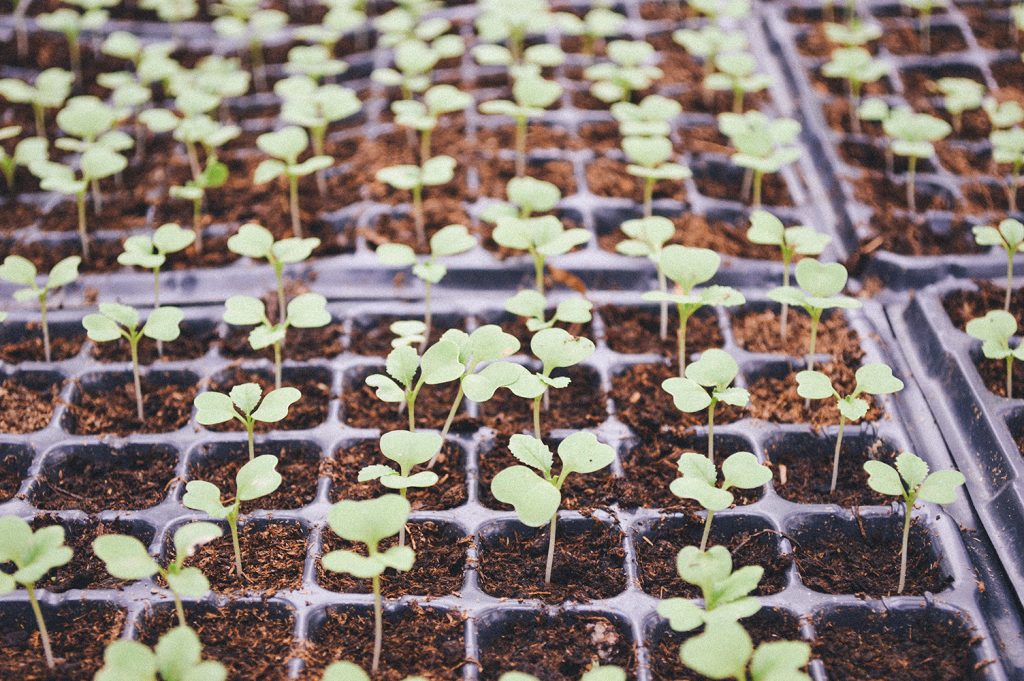Multitasking is a way of life for many of us, although it would appear that with ever-shrinking budgets, counselors in nonprofit settings have made a true art of it. We can no longer afford to do something that only covers one area. Instead we need to reach deeper to do more with less.
Thankfully, there is a way to mix therapy, education, recreation, nature, beautification, nutrition and holistic health — planting a vegetable garden. The best part? The effort requires little in the way of money for startup and even less in future years.
What is needed
- South-facing areas: windows, pathways, greenways (anyplace that gets direct sunlight daily)
- Access to water
- Planting space: garden areas, pots, planters or anything that can hold soil and seeds. Be creative. We once used a windowsill and gallon milk jugs with the tops cut off.
- Basic tools: Depending on the size and scope of the project, you might need common gardening tools or nothing more than the ability to open a bag of soil. For larger areas, you will want a hoe, garden shovel, watering can or garden hose, and clippers.
- Seeds
- Fertilizer
- Storage area for tools, supplies and vegetables
- Patience
How it’s done
All you need is a basic desire to plant and grow vegetables. If you use non-GMO (genetically modified organism) and nonhybrid seeds, you can collect seeds from the vegetables you grow for use in future planting. This allows for minimal startup and sustainability costs. (Note: GMO seeds can be controversial, and at times you are not allowed to collect and save the seeds because of arcane laws. Hybrid seeds are poor choices for saving because they are made from a blend of plants, and the resulting seeds are unpredictable.) If space allows, you can compost any nonedible or spoiled greens. Reusing this compost limits the need to purchase supplemental fertilizers.
Starting the program can take many paths. It can involve simply recruiting a few interested staff members, or it can involve putting out a call to the community (including those whom your nonprofit serves) to look for volunteers. I recommend having a key point person to supply basic information to interested participants. This includes educating them on how this effort ties into positive mental and physical health. The point person will also provide basic training.
Have folks commit to an activity either on a one-time basis or as an ongoing chore. A feeling of ownership will help develop their sense of belonging to the greater community. It can also help to build self-esteem, responsibility and confidence.
What to do with the products
Some nonprofits sell the vegetables they grow as a fundraiser. Others simply share the vegetables with those who participated in the project, and still others share with the volunteers and with the greater community. There is no right answer.
Case study
Here at Pillwillop Therapeutic Farm, we elected to go big with our community growing program by making field areas open to volunteers. The idea was that we could educate on nutrition, share what is harvested with volunteers and those in need, and add a small “take what you need, leave what you can” farm stand.
The first few years were marked with both successes and challenges (broccoli remains my greatest foe, as we have yet to have any real success with it). Starting with a few shovels in the dirt and water collected by hand from a nearby brook, we regularly invested in programming as possible. Applying for competitive grants and other income resources led to a $10,000 “Seeds of Change” grant, as well as other grants, which enabled us to expand our offerings greatly.
We invested thousands of dollars and thousands of man-hours to build infrastructure such as year-round water access to some fields, seasonal access to others and drip irrigation with timers to help preserve water and reduce labor. We also built two large greenhouses (“seasonal high tunnels” in government nomenclature), complete with lights, power outlets and several ADA-compliant planting beds.
We put periodic calls out for volunteers and tried to have volunteers take on leadership roles whenever possible. By modifying our planting processes, we were able to include those who are normally excluded from such programming, including older adults, those with disabilities and those who have allergies to the sun (lighting allows for nighttime planting, care and harvesting). The greenhouses, though unheated, allow for nine to 10 months of garden programming in our area of New England. In fact, April marked our first opportunity of the year to harvest cold-weather crops. We have had limited harvesting go into December.
All told, we have received very positive feedback from volunteers and the community at large. We have helped provide high-quality organic food to those who otherwise would not have access to it and have helped inspire other programs and individuals to start pocket-garden centers and personal plots. We have also seen the emergence of a real community where once there was only unused land.
Results
Results will vary of course, but with a little effort, some time, minimal money and community involvement, you may find that adding beauty to your nonprofit counseling program will not only help the hungry but also fill a need in your program and community.
My advice? Start as small as you need. A few cups on a windowsill in an inner-city office might lead to a rooftop garden or other community garden program.
*****
Here are some links to gardening resources for those who are interested:
- seedsofchange.com — We have used this company’s seeds and were fortunate to win a competitive grant from them. They appear to be very community minded, and their prices are fair.
- seedsavers.org — We just discovered this company, and this is our first year using their seeds. We were very impressed with their commitment to seed saving and promoting education on seed saving and gardening practices. You would think that educating about and promoting seed saving would be contrary to a company that sells seeds, and it is, but their greater mission is to help folks be self-sufficient and to also promote education, gardening etc.
- johnnyseeds.com — I haven’t ordered from this company myself because I already had sources, but many of our garden friends swear by them and the quality of their seeds.
- reimerseeds.com — I have read some negative reviews online, but in the three or so years that we have ordered tomato seeds from this company, we have had nothing but good experiences. They came highly recommended by a local commercial gardener.
This list is not meant to be exhaustive, nor is it an endorsement. There are many other great seed companies out there. It is important to explore seeds and companies to see what works best for you in terms of customer service and results in your particular environment and soil type.
****

“Doc Warren” Corson III is a counselor, educator, writer and the founder, developer, and clinical and executive director of Community Counseling Centers of Central CT Inc. (www.docwarren.org) and Pillwillop Therapeutic Farm (www.pillwillop.org). Contact him at docwarren@docwarren.org. Additional resources related to nonprofit design, documentation and related information can be found at docwarren.org/supervisionservices/resourcesforclinicians.html.
****
Opinions expressed and statements made in articles appearing on CT Online should not be assumed to represent the opinions of the editors or policies of the American Counseling Association.
